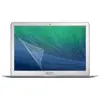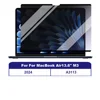Apple’s most popular Mac laptop is the MacBook Air, which offers a great combination of features for the typical user, but there is another MacBook to consider – the more powerful MacBook Pro. In this feature we aim to help those who want to buy an Apple laptop, but aren’t sure what the difference between the MacBook Air and the MacBook Pro is.
We’ll explain the advantages and disadvantages of buying a MacBook Air or MacBook Pro, we’ll discuss what makes the MacBooK Air so popular, and we’ll talk about which uses each Mac laptop is best suited to.
We’ll also look in depth at the various specs and features of the MacBook Air and MacBook Pro so you can see how the MacBook Air and MacBook Pro compare in terms of price, display, design, processor, graphics, storage, RAM and more.
Since budget is often the main issue, we’ll start with price and how much you get for your money.
For advice about the best MacBook, we also have a buying guide, see: Best MacBook: Which Mac laptop is best? We also offer advice about how much storage, RAM and cores in How much MacBook RAM, SSD, Cores do you need? Off to university? Read our guide to the best MacBook for students. For even more information you may be interested to read Which MacBook Pro.
MacBook Air vs MacBook Pro Price: Best value for money MacBook
When Apple introduced the M4 version of the MacBook Air in March 2025 it dropped the price by $100/£100. As a result, the price gap is even larger between the MacBook Pro and MacBook Air.
With no ‘budget’ MacBook Pro available, the MacBook Air is the only option for those looking for a bargain. If you are looking for the cheapest option the $999/£999 MacBook Air would appear to be the clear winner. Consider spending $200/£200 more to get the 10-core CPU/10-core GPU 512GB MacBook Air, which is worth every extra penny.
The price of the MacBook Pro is higher, and on everyday tasks it performs the same as the MacBook Air, but it does offer better performance on long, CPU-intensive tasks, like image and video rendering and similar tasks. (Not to mention the better screen, HDMI port, and SDXC Card slot.) At $200/£200 more than the 15-inch MacBook Air with M4 and the same 512GB SSD, it actually represents good value for money, although the price jump is slightly more than it was with the last generation.
Apple 13-inch MacBook Air – Apple’s cheapest MacBook
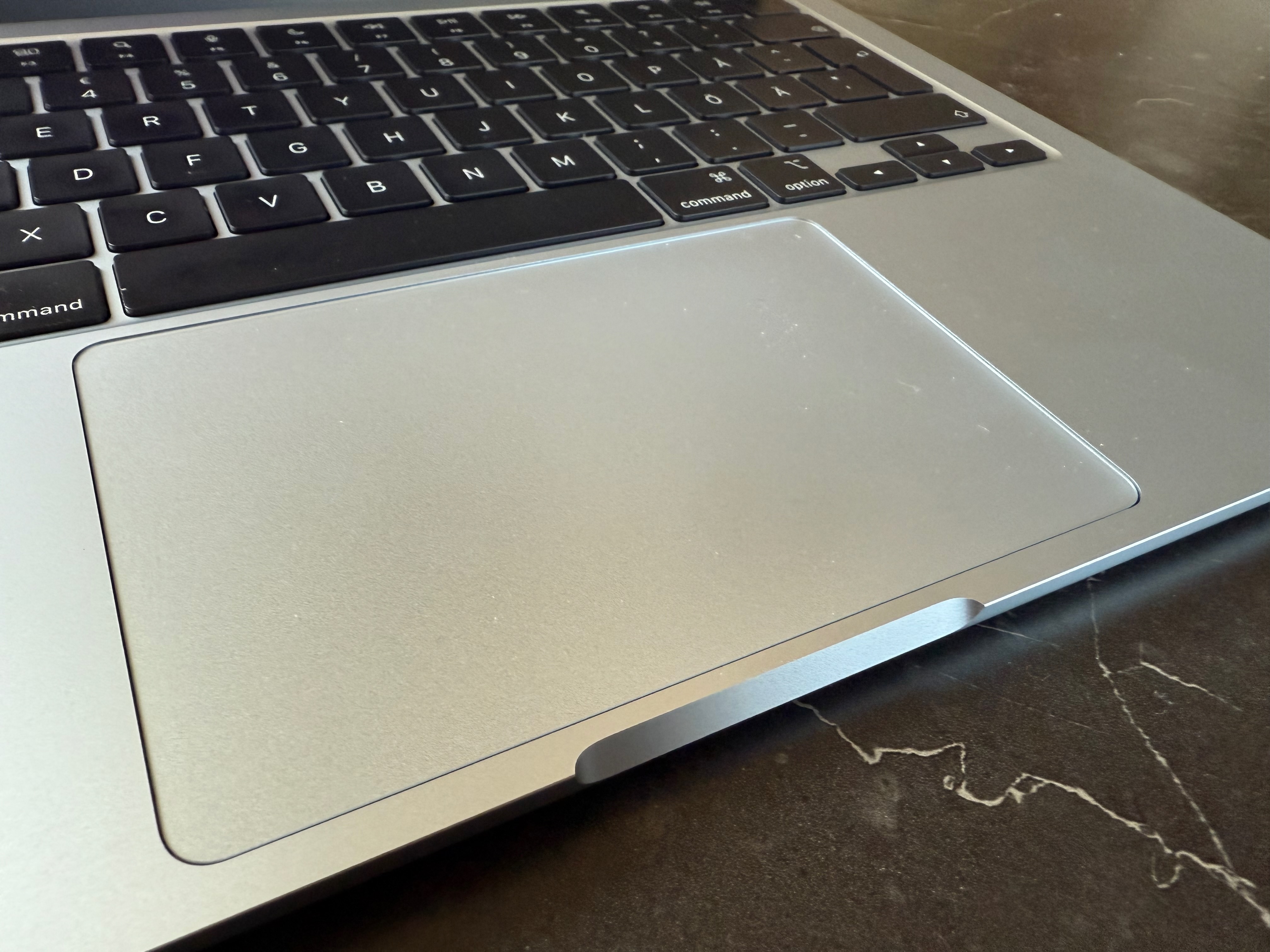
Pros
- Low price
Cons
- Slower than MacBook Pro
Price When Reviewed:
$999
Best Prices Today:
The cheapest MacBook Air you can buy is the 13-inch M4 MacBook Air, which was last updated in March 2025 and starts at $999/£999. For that you get an M4 chip with 10-core CPU, 8-core GPU, 16GB memory, and a 256GB SSD.
Spend $200/£200 more and you can get a slightly better 10-core CPU plus double the storage, at 512GB. That’s $1,199/£1,199.
For $1,399/£1,399 you can get more unified memory (Apple’s name for RAM): 24GB instead of 16GB.
Those are the standard configurations. There are more build-to-order options available that include 32GB unified memory, and 1TB or 2TB SSD.
Who is the 13-inch MacBook Air for?
This is the Mac for the majority. If you want a truly portable Mac laptop the MacBook Air is it. If you are looking for the cheapest Mac though that would be the Mac mini. If the price is still too high for you look for deals on the previous generation here: Best MacBook Air deals.
Read: M4 MacBook Air: Everything you need to know for more information.
Apple 15-Inch MacBook Air – Cheapest big screen MacBook
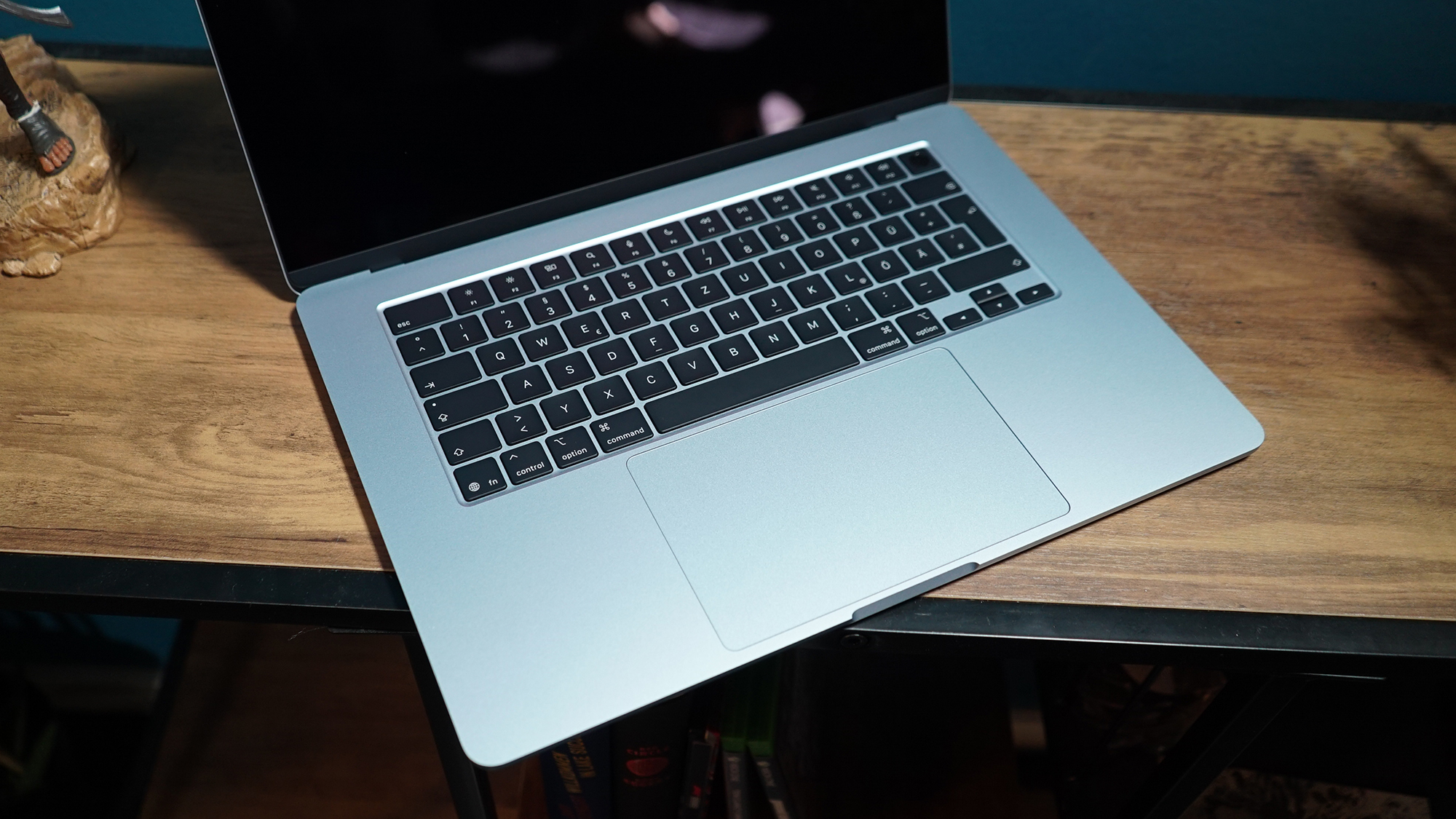
Pros
- Large screen at a good price
Cons
- Slower than MacBook Pro
Price When Reviewed:
$1,199
Best Prices Today:
If you want a larger screen then the cheapest option is the 15-inch MacBook Air. This Mac shares many of the specs of the 13-inch model, but offers a 15-inch display.
The cheapest 15-inch MacBook Air you can buy was last updated in March 2025 and starts at $1,199/£1,199. For that you get an M4 chip with 10-core CPU, 10-core GPU, 16GB memory, and a 256GB SSD.
Spend $200/£200 more and you can get double the SSD at 512GB. That’s $1,399/£1,399.
For $1,599/£1,599 you can get more unified memory (Apple’s name for RAM): 24GB instead of 16GB.
Those are the standard configurations. There are more build-to-order options available that include 32GB unified memory, and 1TB or 2TB SSD.
Who is the 15-inch MacBook Air for?
If you want a bigger display and budget doesn’t run to the MacBook Pro the MacBook Air with 15-inch display will be sufficient. If you need more power, you could look for an discount on an older MacBook Pro model.
Read our full
Apple 15-inch MacBook Air (M4, 2025) review
Apple 14-inch MacBook Pro – More power, higher price
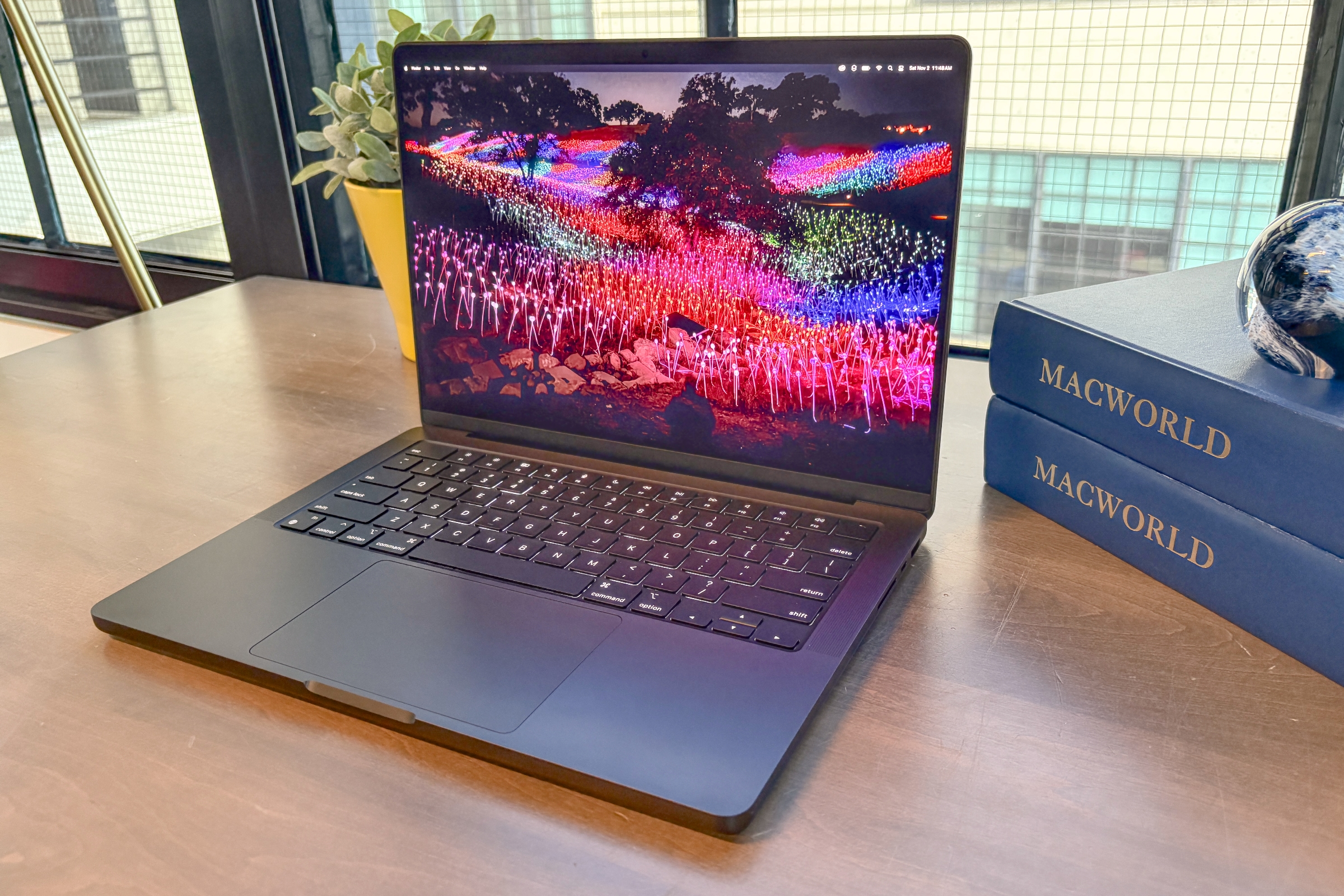
Pros
- All MacBook Pro models have superior display
- Excellent battery life for M4 model
Cons
- High price, even for M4 model
- M4 Pro/Max models have worse battery life
Price When Reviewed:
$1,599 | $1,799 | $1,999
Best Prices Today:
The M4 MacBook Pro arrived in October 2024. The MacBook Air that arrived in March 2025 has the same processor, so you might be forgiven for thinking that the two laptops are identical, but they aren’t.
The most obvious indication that the MacBook Air and MacBook Pro are different beasts is the price. The 14-inch MacBook Pro starts at $1,599/£1,599. That’s $400/£400 more than the entry-level MacBook Air. Those two Macs aren’t really comparable though.
The MacBook Pro M4 has an 10-core CPU, 10-core GPU, 16GB memory, and a 512GB SSD, so it’s actually more like the 13-inch MacBook Air with 512GB SSD for $1,199/£1,199 or the equivalent 15-inch MacBook Air with 512GB SSD for $1,399/£1,399.
What are you getting for the extra money if you choose a MacBook Pro? We’ll discuss this in a lot more detail below, but, essentially, you get a Mac with a better display, better heat management, better battery life, better audio and more ports. All of those features may be well worth the extra expense when compared to the MacBook Air.
There is also a lot more choice when it comes to the components of the MacBook Pro. The M4 models can support up to 2TB SSD and 32GB RAM, like the MacBook Air, but there are also more powerful M4 Pro and M4 Max models, with the M4 Pro supporting up to 48GB RAM and the M4 Max supporting up to 128GB RAM.
The M4 Pro can support up to 14-core CPU and 20-core GPU, while the M4 Mac can support up to 40-core GPU. Those models come with an exceptionally high price though, starting at $1,999/£1,999 for the M4 Pro and $3,199/£3,199 for the M4 Max. More on the specs below.
To get the best deal on a MacBook Pro read our round up of the Best MacBook Pro deals.
Who is the 14-inch MacBook Pro for?
For those with average requirements, the M4 MacBook Pro is sufficient and better suited to processor intensive operations than the MacBook Air. This is a Mac to choose if you need a little more oomph than the MacBook Air can give but don’t have the money for a MacBook Pro with M4 Pro chip.
If you need a bit more power and have the budget for the M4 Pro or M4 Max models the 14-inch MacBook Pro offers better value for money than it’s bigger screened sibling.
We also discuss the M4 Pro and M4 Max MacBook Pro models in our MacBook Pro comparison and our Best MacBook guide.
Read our full
Apple 14-inch MacBook Pro (M4, 2024) review
Apple 16-inch MacBook Pro – Ultimate Mac laptop
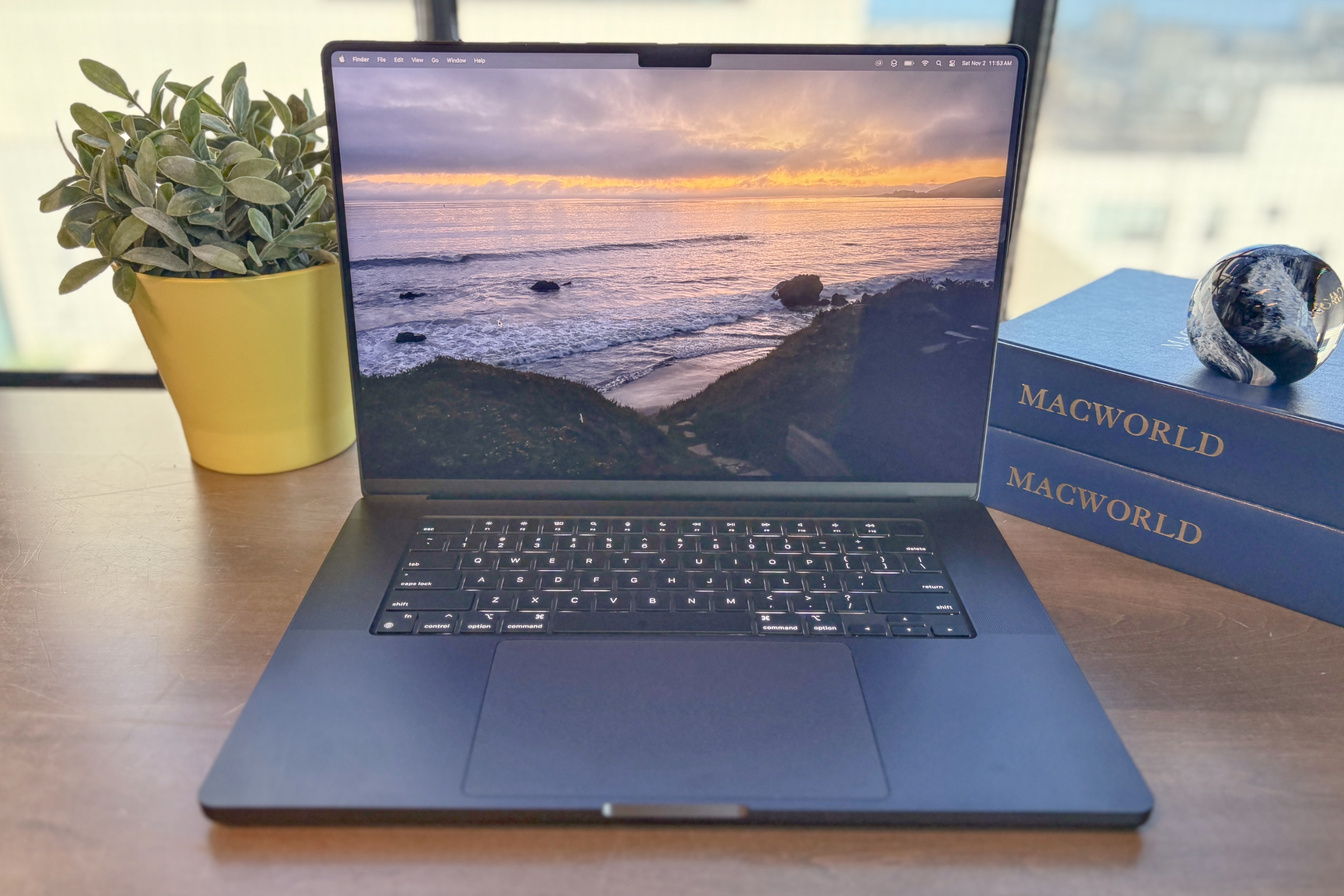
Pros
- Excellent battery life
Cons
- Very high price
Price When Reviewed:
$2,499 | $2,899
Best Prices Today:
There is one more MacBook Pro to consider. The 16-inch MacBook Pro.
The 16-inch MacBook Pro comes with M4 Pro or M4 Max chip, there is no standard M4 option here. The entry price is a hefty $2,499/£2,499 for an M4 Pro, 14-core CPU, 20-core GPU, 24GB Unified Memory, and 512GB SSD. The equivalent 14-inch model costs $2,399/£2,399, but has twice as much storage at 1TB. The M4 Pro can support up to 48GB unified memory in the MacBook Pro.
The specs are similar to the 14-inch MacBook Pro, with the option of upgrading to an M4 Max with up to 40-core GPU, up to 128GB Unified Memory, and up to 8TB SSD.
What are you getting for the extra money if you choose a 16-inch MacBook Pro over the 14-inch model? Other than the bigger screen, you get better battery life, but not really anything else. We’ll discuss this in a lot more detail below.
Who is the 16-inch MacBook Pro for?
The 16-inch MacBook Pro is the ultimate Mac, but it doesn’t offer better specs than the 14-inch MacBook Pro. All it offers is a bigger display and netter battery life – both of which may be the most important factor in your decision. If you need a big screened powerful Mac get the 16-inch MacBook Pro, or consider a 14-inch MacBook Pro with an external display. Take a look at the Best Mac monitors and displays we have reviewed.
Read our full
Apple 16-inch MacBook Pro (M4 Pro, 2024) review
MacBook Air vs MacBook Pro: Design
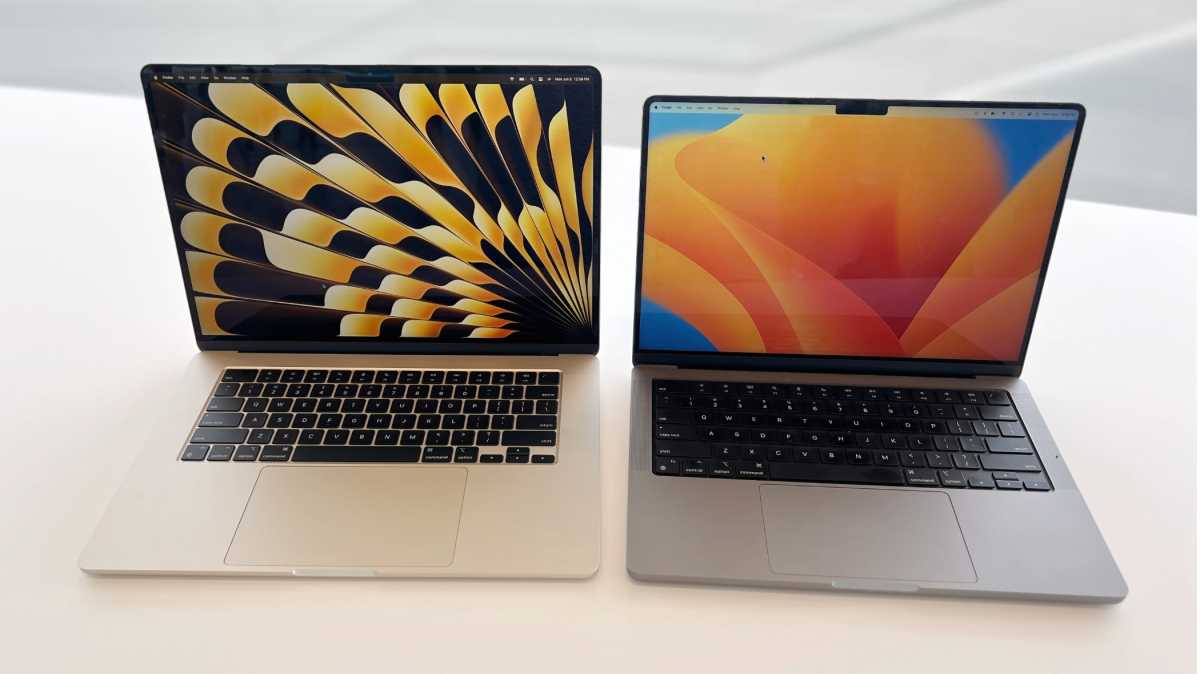
Foundry
Following a redesign of the MacBook Air in June 2022, you could have been forgiven for thinking you were looking at a MacBook Pro. Gone is the tapered edge for which the Air was famous, replaced with a more uniform design. The MacBook Air is still thinner – albeit fractionally – but it is also very slightly larger than the old version of the Air, thanks to the bigger screen.
Both the MacBook Air and MacBook Pro have a notch at the top of the screen as see on some iPhone models. It’s not a bad thing, but some people don’t like notches. The notch conceals the FaceTime camera, which, with the introduction of the M4 MacBook Air, is now the same 12MP Center Stage camera with support for Desk View and 1080p HD video recording on all models.
Despite the presence of the iPhone-like notch, MacBooks do not offer Face ID for unlocking. Instead all MacBook’s have a Touch ID sensor built into the keyboard, so you can just tap your finger on there to unlock things and enter passwords.
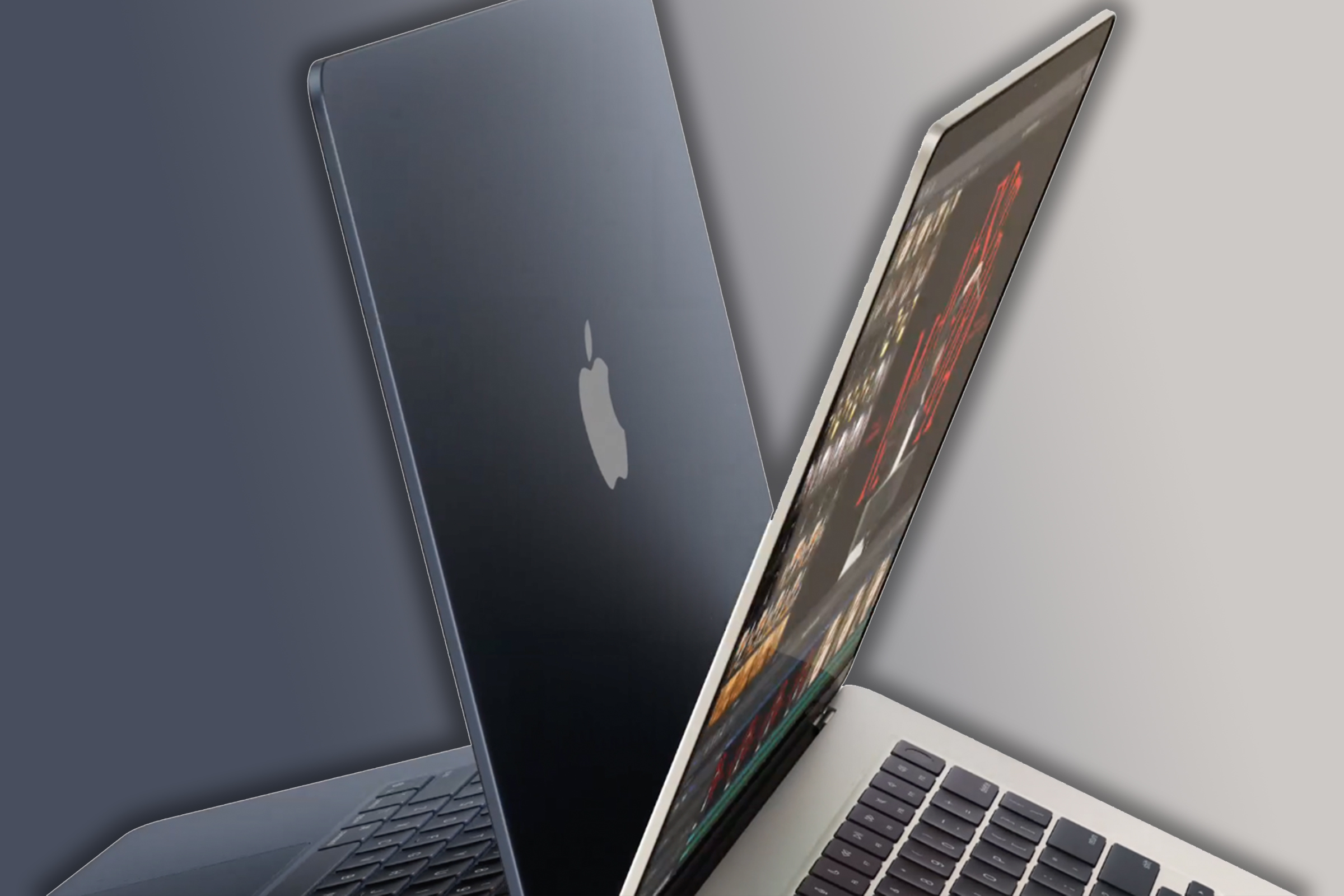
Foundry
One key difference between these MacBooks is the color choices. There are four color choices for the 13-inch MacBook Air and the 15-inch MacBook Air: Midnight (dark blue), Starlight (gold), Sky Blue and Silver. Apple introduced the Sky Blue option with the M4 MacBook Air and discontinued the Space Gray option (to the dismay of some). The Starlight shade is paler gold, while Midnight is close to black with a dark blue hue.
The 14-inch and 16-inch MacBook Pro offer only Silver and Space Black options.
MacBook Air vs MacBook Pro: Dimensions
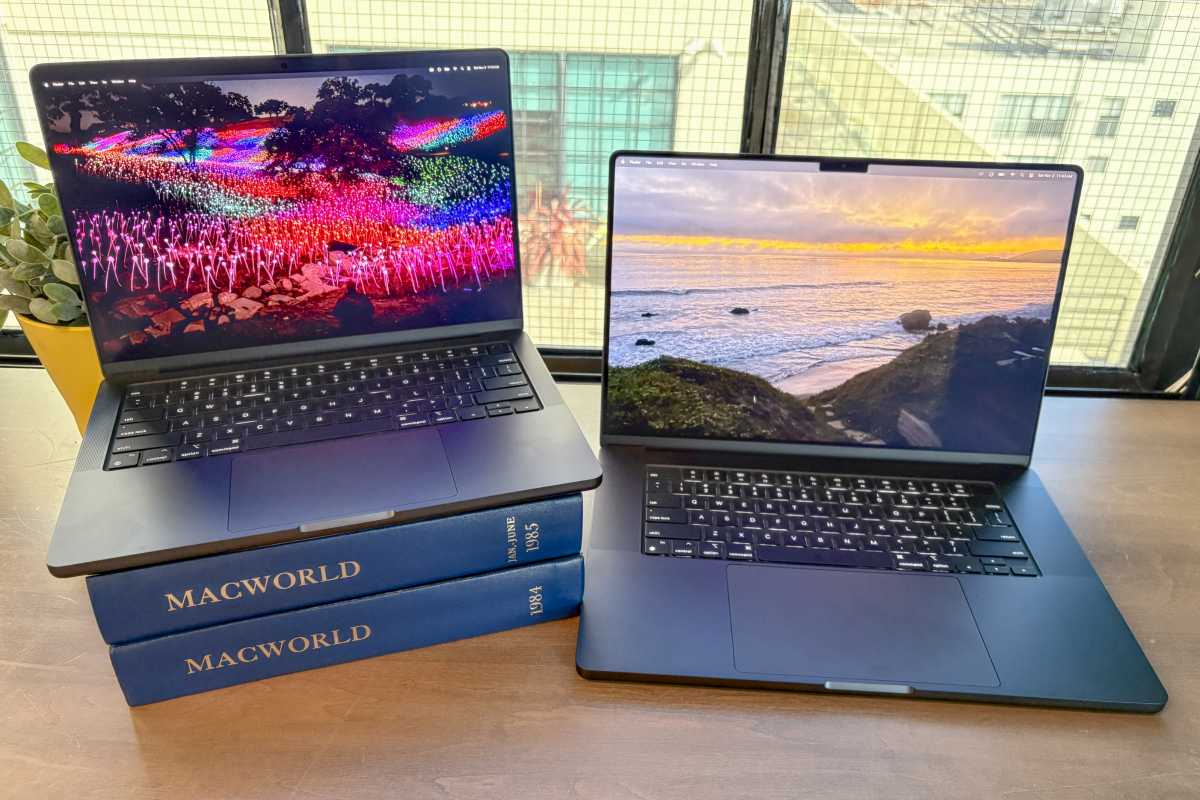
Foundry
Apple refers to them as the 13-inch and 15-inch MacBook Air and the 14-inch and 15-inch MacBook Pro. The measurements are based on the screen size, but those numbers are actually not accurate. Here’s what the real screen measurements are:
- The screen on the 13-inch MacBook Air measures 13.6-inches diagonally.
- The screen on the 15-inch MacBook Air measures 15.3-inches diagonally.
- The screen on the 14-inch MacBook Pro measures 14.2-inches diagonally.
- The screen on the 16-inch MacBook Pro measures 16.2-inches diagonally.
A larger display doesn’t necessarily mean the Mac is bigger and heavier though. The 15-inch Air is thinner, so it not only weighs less than the 16-inch MacBook Pro, it is also lighter than the 14-inch MacBook Pro due to the fans needed for heat dissipation in the more powerful machine.
- 16-inch MacBook Pro, M4 Pro: 4.7 pounds (2.14 kg), M4 Max: 4.7 pounds (2.15 kg)
- 14-inch MacBook Pro, M4 Pro: 3.5 pounds (1.60 kg), M4 Max: 3.6 pounds (1.62 kg)
- 14-inch MacBook Pro, M4: 3.4 pounds (1.55 kg)
- 15-inch MacBook Air, M4: 3.3 pounds (1.51 kg)
- 13-inch MacBook Air, M4: 2.7 pounds (1.24 kg)
From the figures above, you’ll notice that the M4 Pro and M4 Max models weigh a little bit more than the M4 MacBook Pro.
And as you can see from the below, the 13-inch MacBook Air dimensions aren’t much smaller than those of the 14-inch MacBook Air. Given that there is actually only half an inch (0.6in) difference in screen size, this shouldn’t be surprising.
- 16-inch MacBook Pro, M4: 14.01 x 9.77 x 0.66 inches (35.57 x 24.81 x 1.68cm)
- 15-inch MacBook Air, M4: 13.40 x 9.35 x 0.45 inches (34.04 x 23.76 x 1.15cm)
- 14-inch MacBook Pro, M4: 12.31 x 8.71 x 0.61 inches (31.26 x 22.12 x 1.55cm)
- 13-inch MacBook Air, M4: 11.97 x 8.46 x 0.44 inches (30.41 x 21.5 x 1.13cm)
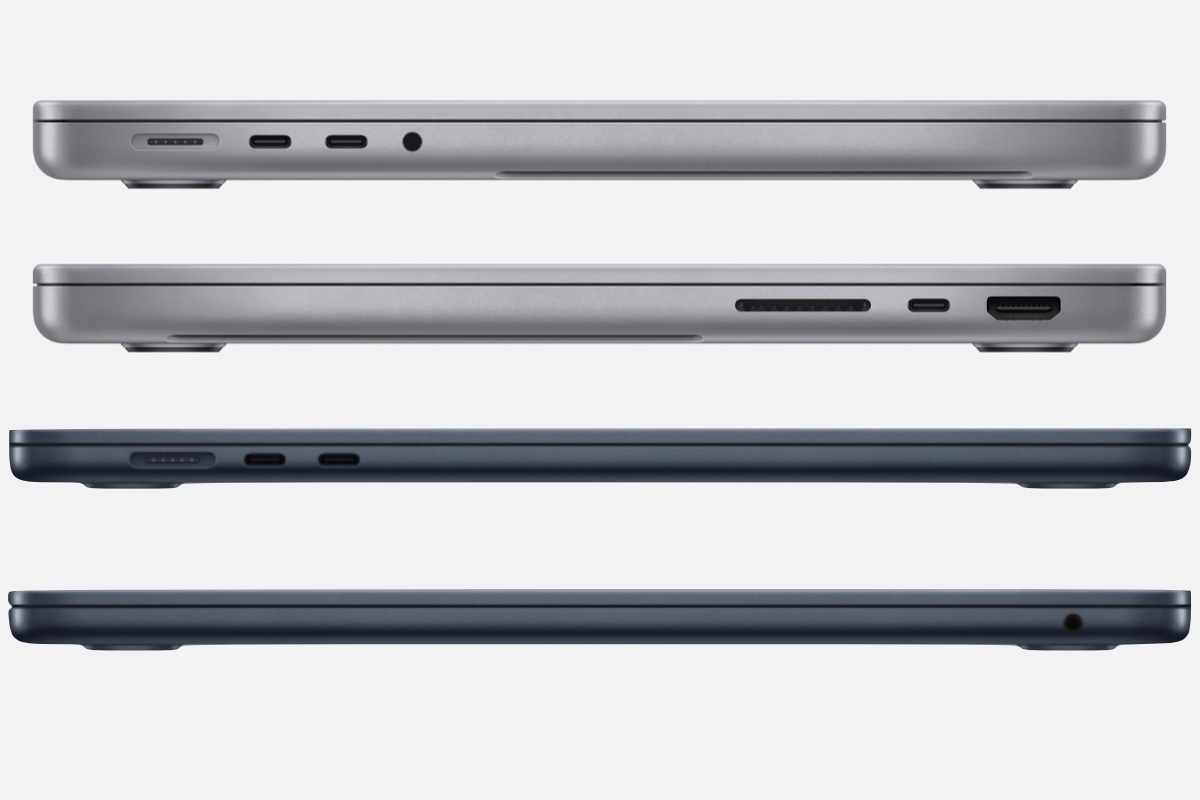
Apple
MacBook Air vs MacBook Pro: Display
We mentioned the size of the screens already, but there is to separate the displays than diagonal measurements.
- 13-inch MacBook Air: 13.6 inches diagonal, 2,560 by 1,664 pixels
- 14-inch MacBook Pro: 14.2 inches diagonal, 3,024 by 1,964 pixels
- 15-inch MacBook Air: 15.3 inches diagonal, 2,880 by 1,864 pixels
- 16-inch MacBook Pro: 16.2-inches diagonal, 3,456 by 2,234 pixels
You’ll notice from the above that there are significantly more pixels on the MacBook Pro screens – even when compared to a larger MacBook Air model.
The MacBook Air has what Apple calls a Liquid Retina display. The MacBook Pro has a superior Liquid Retina XDR panel. The image quality is significantly better on the MacBook Pro. However, to the average person the screen quality of the MacBook Air will be more than sufficient.
It’s not just fewer pixels. Both Airs have a maximum brightness of 500 nits, which is half of the Pro’s 1,000 nits in normal use, or a third if you’re running HDR content at a max of 1,600 nits of which the MacBook Pro is capable. This is achieved by the Pro display incorporating mini-LEDs rather than the Air’s standard LCD screen.
Perhaps the biggest difference though is that the Pro features ProMotion, meaning that the refresh rate tops out at 120Hz, again double that of the Air’s 60Hz refresh rate. This helps keep scrolling and animations smooth and crisp. Any of these displays will be great for everyday use and long hours of work, but the Pro has the edge when it comes to features.
And there is more. With the M4 MacBook Pro, Apple introduced a nano-texture glass option that has a matte-like finish for $150. This option is not available on the MacBook Air, and if you need to cut down the glare from the display, it’s a feature to consider.
All of this is mute if you will plug your Mac into a display, of course, in which case you can buy a display that offers you the screen quality you need.
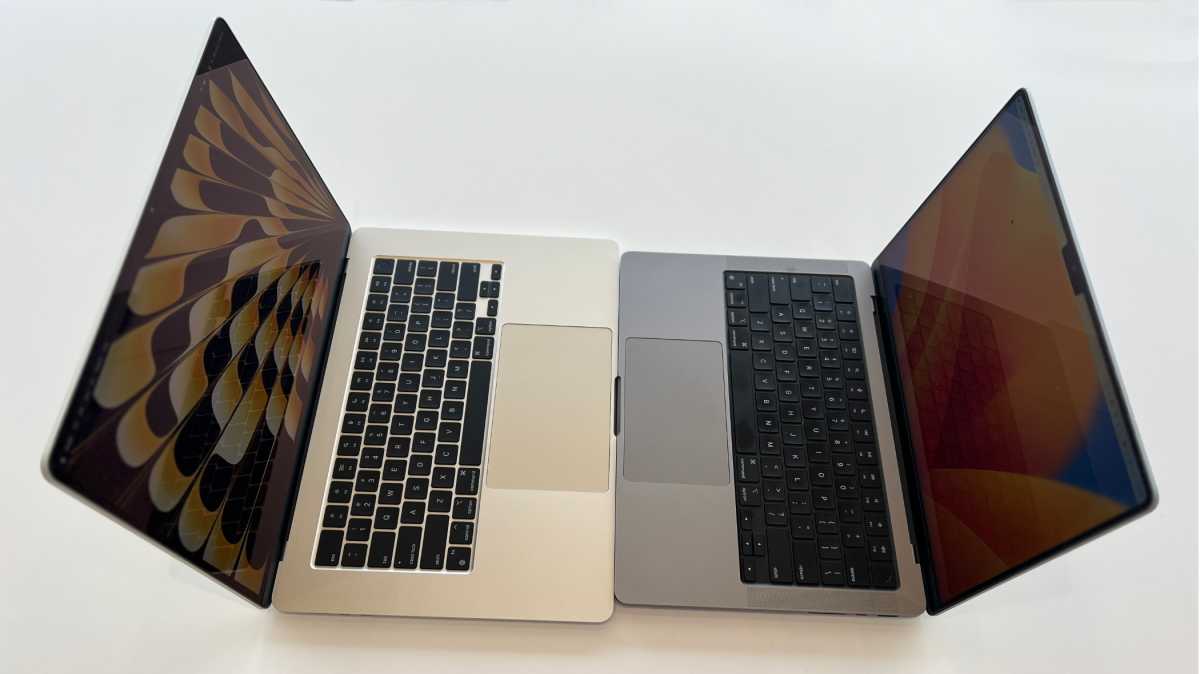
Foundry
MacBook Air vs MacBook Pro: Processor
All of Apple’s laptops are powered by Apple’s silicon and right now the latest Apple chip is the M4, which comes in the following varieties: M4, M4 Pro and M4 Max. To learn more about all the Mac processors read our Mac processor comparison.
When it comes to the processor specs the MacBook Pro and MacBook Air actually look pretty well matched, as shown by this table.
| MacBook | Price | CPU | GPU | Memory | SSD |
|---|---|---|---|---|---|
| 13.6-inch MacBook Air, M4 (2025) | $999/£999 | 10-core, M4 | 8-core, M4 | 16GB (up to 32GB) | 256GB SSD |
| 13.6-inch MacBook Air, M4 (2025) | $1,199/£1,199 | 10-core, M4 | 10-core, M4 | 16GB (up to 32GB) | 512GB SSD |
| 13.6-inch MacBook Air, M4 (2025) | $1,399/£1,399 | 10-core, M4 | 10-core, M4 | 24GB (up to 32GB) | 512GB SSD |
| 15-inch MacBook Air, M4 (2025) | $1,199/£1,199 | 10-core, M4 | 10-core, M4 | 16GB (up to 32GB) | 256GB SSD |
| 15-inch MacBook Air, M4(2025) | $1,399/£1,399 | 10-core, M4 | 10-core, M4 | 16GB (up to 32GB) | 512GB SSD |
| 15-inch MacBook Air, M4 (2025) | $1,599/£1,599 | 10-core, M4 | 10-core, M4 | 24GB (up to 32GB) | 512GB SSD |
| 14-inch MacBook Pro, M4 (2024) | $1,599/£1,599 | 10-core, M4 | 10-core, M4 | 16GB (up to 32GB) | 512GB SSD |
| 14-inch MacBook Pro, M4 (2024) | $1,799/£1,799 | 10-core, M4 | 10-core, M4 | 16GB (up to 32GB) | 1TB SSD |
| 14-inch MacBook Pro, M4 (2024) | $1,999/£1,999 | 10-core, M4 | 10-core, M4 | 24GB (up to 32GB) | 1TB SSD |
However, there is a difference in terms of how well the processors perform in the different models, as you can see from the Geekbench and Cinebench results below. A similarly specced MacBook Pro performs better than the MacBook Air, albeit only slightly beter.
- The M4 15-inch MacBook Air scored 14680 in the multiple CPU Geekbench and 3907 in the GPU test for Cinebench 2024.
- The M4 14-inch MacBook Pro scored 14763 in the multiple CPU Geekbench and 3997 in the GPU test for Cinebench 2024.
- The M4 Pro 16-inch MacBook Pro scored 22406 in the multiple CPU Geekbench and 9297 in the GPU test for Cinebench 2024.
The chart below shows the Geekbench results for the various processors.
The MacBook Air is slower because in order for it to be so compact it is fanless, which means it is less able to manage heat, and therefore may run slower in order to keep cool if you really push it. If it’s power you need then, as the benchmarks show, a MacBook Pro will have the edge.
However, that’s not to say that the M4 MacBook Air is slow. As you can see from the scores above, the M4 shoots ahead of the M3, M2 and M1, in fact it even scores above the M3 Pro. The M4 MacBook Air is plenty powerful enough for most people, and likely way better than any old Mac you are replacing.
If you really need a powerful machine you might want to consider the M4 Pro MacBook Pro.
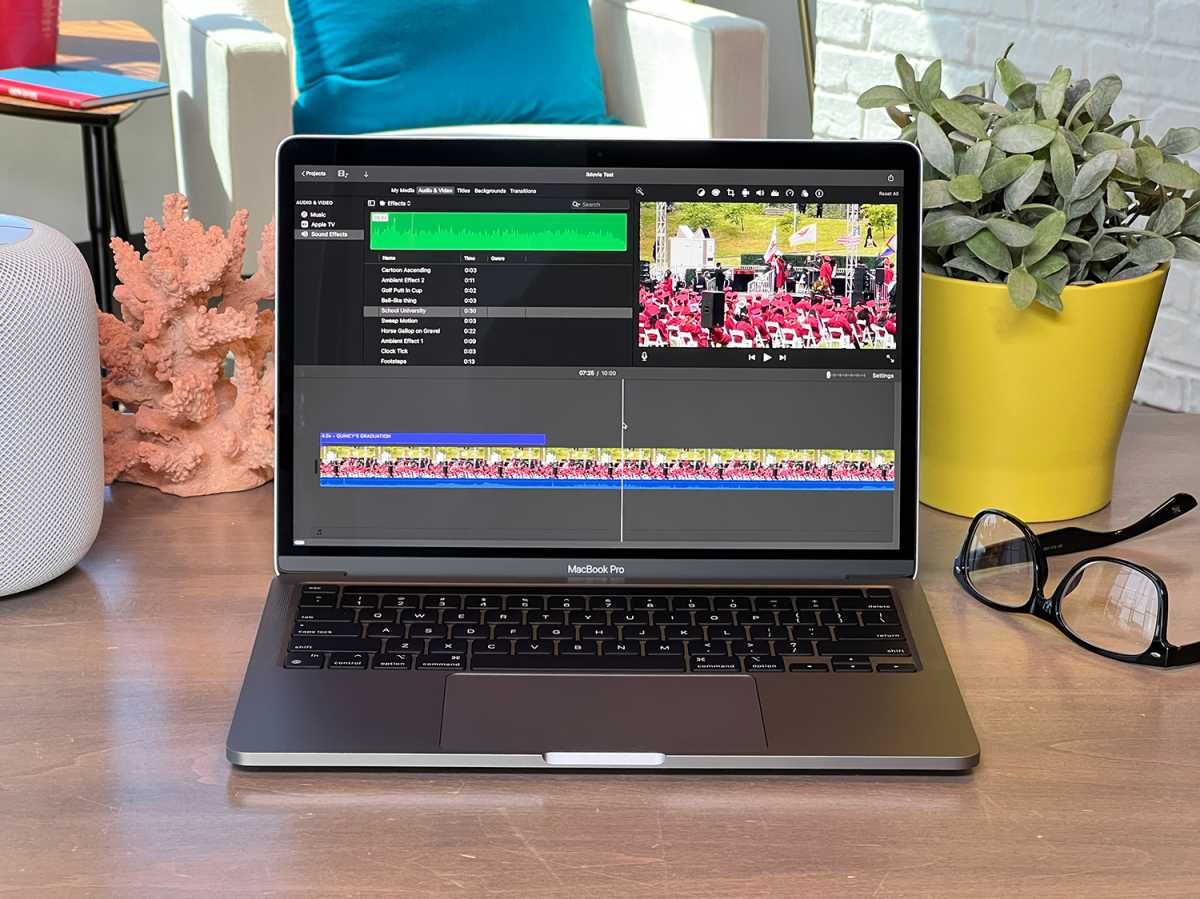
Foundry
MacBook Air vs MacBook Pro: RAM (unified memory)
Prior to October 2024, many Macs shipped with just 8GB RAM as standard. These days a Mac may struggle with just 8GB RAM so Apple has upped this allocation, and since October 2024 all MacBook Air and MacBook Pro ship with at least 16GB RAM as standard. There is an option to increase unified memory to 24GB or 32GB in the M4 MacBook Pro and Air.
If you need more memory you will need to look to the MacBook Pro with M4 Pro or M4 Max. With the M4 Pro you can get up to 48GB unified memory, while the M4 Max can support up to 128GB memory.
Our advice is to get as much RAM as you can afford when you buy the Mac, as you can’t upgrade it later.
MacBook Air vs MacBook Pro: Storage
Apple offers a 256GB storage option at the entry-level for both the 13-inch and 15-inch MacBook Air. The entry-level MacBook Pro starts at 512GB. There is the option to add 1TB or 2TB SSD to both laptops.
While a 2556GB SSD might prove to be enough for you, especially if you use iCloud or other cloud based services to supplement your storage. But 512GB might be a better option, as we found, see: Here’s proof that a 256GB SSD is too small for a Mac in 2025.
Another reason to avoid the 256GB model: in previous generations, there were some concerns about this 256GB SSD, with reports that its SSD is up to 50 percent slower on read speeds and 30 percent on write speeds. We found that these observations were indeed true when we ran our own set of tests using Blackmagic Disk Speed Test on older MacBook models. In more recent times, this has seemed to be less of an issue. This will only matter if you are using apps that access the SSD often, so it may not make a difference in typical use.
If you want more than 2TB SSD you need to look at the MacBook Pro models with the M4 Pro and M4 Max which can support up to 8TB SSD.
MacBook Air vs MacBook Pro: Battery life and charging
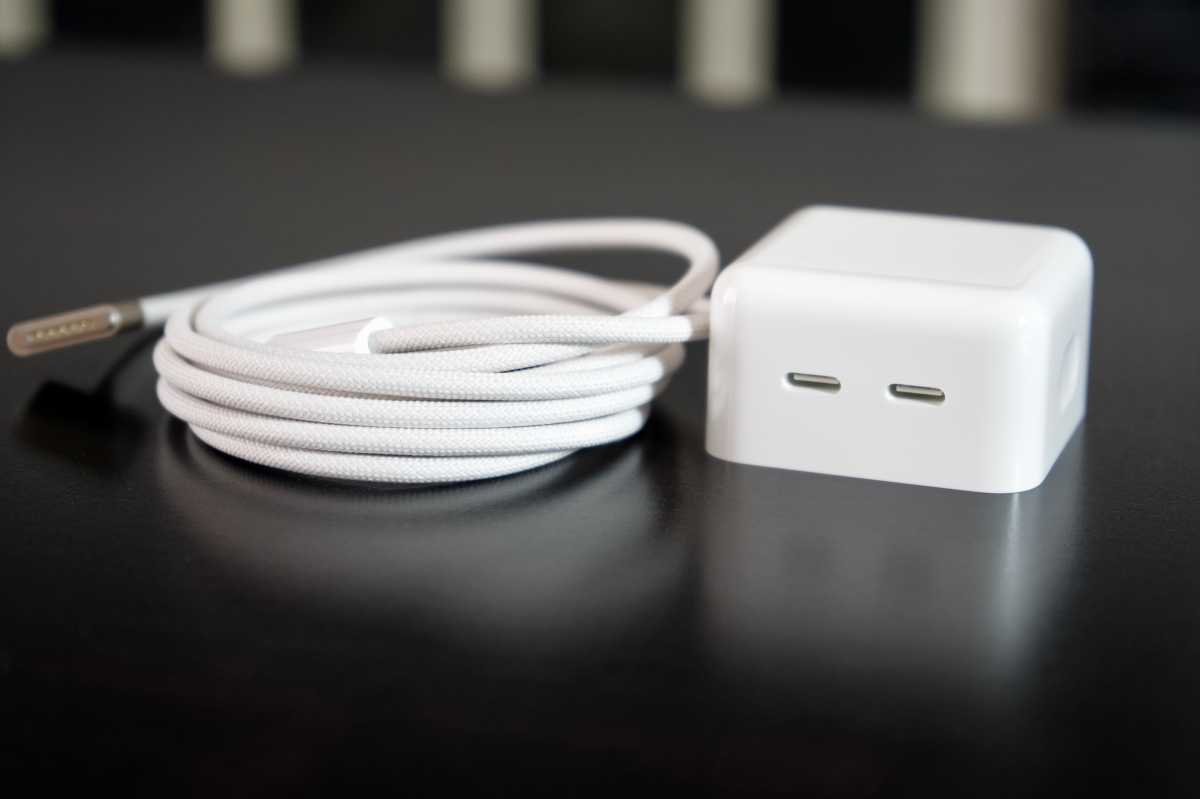
IDG
When it comes to battery life, according to Apple, the MacBook Air offers 18 hours battery life when video streaming, while the 14-inch M4 MacBook Pro offers an 24 hours video streaming. The main reason for this difference is that the 14-inch MacBook Pro has a larger battery: 72.4 watt-hours compared to 66.5 watt-hours in the 15-inch MacBook Air and 53.8 watt-hours in the 13-inch Air. The battery in the 16-inch MacBook Pro is even bigger at 100 watt-hours.
- MacBook Air, 13-inch, M4, 18 hours battery life (Apple)
- MacBook Air, 15-inch, M4, 18 hours battery life (Apple), 1,076 minutes, just under 18 hours (our test)
- MacBook Pro, 14-inch, M4, 24 hours battery life (Apple), 20 hours (our test)
- MacBook Pro, 14-inch, M4 Pro/M4 Max, 22 hours battery life (Apple)
- MacBook Pro, 16-inch, M4 Pro/M4 Max, 24 hours battery life (Apple), 26 hours (our test)
It’s not just how long the battery lasts that matters, but also the charging speed. The entry-level 13-inch MacBook Air ships with a 30W adapter, the other 13-inch Air and the 15-inch MacBook Air ship with a 35W power adapter. The 14-inch MacBook Pro M4, and the entry-level M4 Pro ships with a 70W adapter, the other 14-inch MAcBook Pro models offer a 96W charger, and the 16-inch model has a 140W adapter for even faster charging.
Each 14-inch MacBook Pro can also be fast charged with a 96W adapter (only included with some models) and the MacBook Air can be fast charged with a 70W adapter (not included). See our comparison test of Apple’s MacBook Air chargers as well as the best USB-C charger for your MacBook.
MacBook Air vs MacBook Pro: Ports and expansion
Over the years it’s felt like Apple has been on a mission to remove ports from Macs in order to make them slimmer and slimmer. This has been a disadvantage for many, although generally if you need more or different ports you can just plug in an adapter or a dock (read: Best USB-C hubs and adapters for Mac).
The MacBook Air offers a MagSafe charging port alongside two Thunderbolt 4/USB-C ports.
The MacBook Pro offers an additional Thunderbolt 4/USB-C port, as well as HDMI and SDXC ports.
The arrival of Thunderbolt 4 for this generation means that the M4 MacBooks can support more displays. See: How to connect two or more external displays to an M1, M2, M3 or M4 MacBook.
Connectivity for both models is via Bluetooth 5.3 and Wi-Fi 6E. All Mac laptops offer a 3.5mm headphone jack.
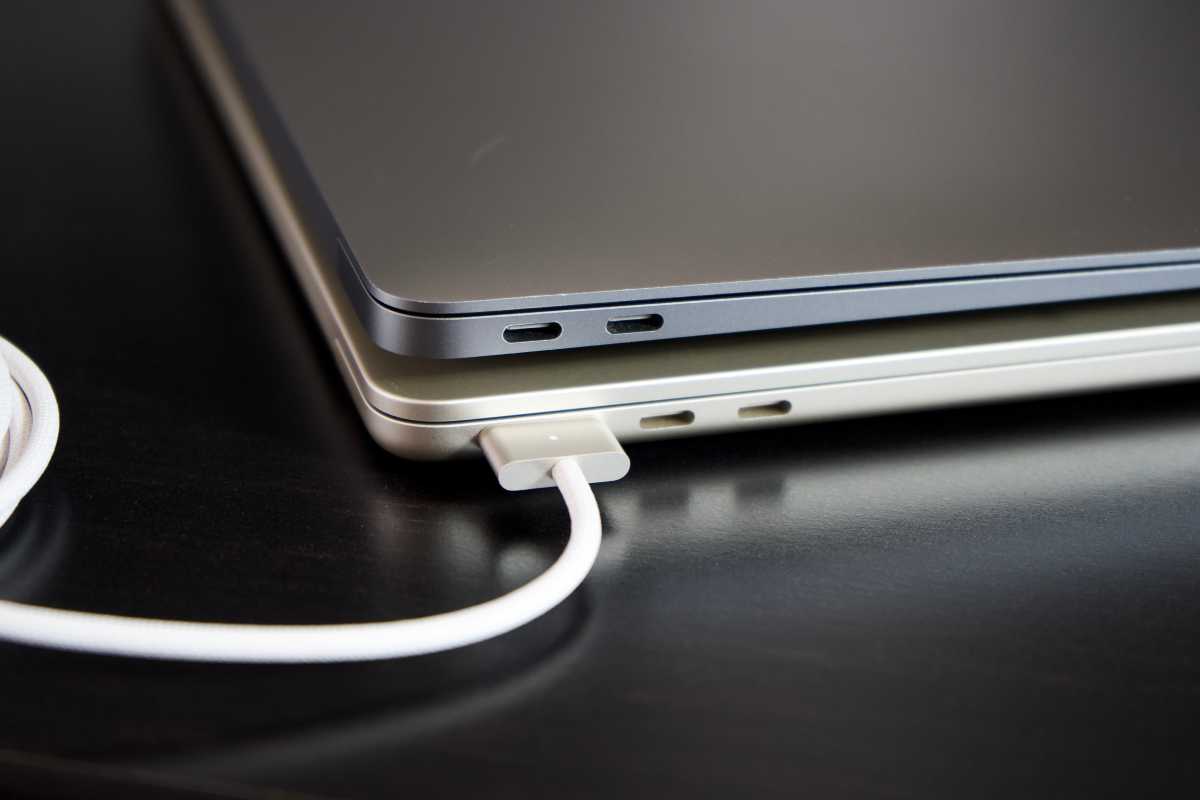
IDG
MacBook Air vs MacBook Pro: Audio and camera
All of the MacBooks in the current generation offer a 12MP Center Stage camera that automatically keeps the user in the center of the frame. The camera also supports Desk View, which can show the desk space in front of the laptop. This is an upgrade from the M3 MacBooks, which only offered a 1080p FaceTime camera.
The 15-inch MacBook Air has a benefit over the 13-inch MacBook Air model: if features a six-speaker sound system with force-canceling woofers, compared to a four-speaker sound system. Apple describes the speaker system in the 14-inch MacBook Pro as a high-fidelity six-speaker sound system with force-cancelling woofers, indicating that it is superior to that in the 15-inch Air. Apple also refers to a “studio-quality three-mic array with high signal-to-noise ratio and directional beamforming” in the 14-inch Pro, while both Air models offer only a “three-mic array with directional beamforming”.
The MacBook Pro has a better speaker system than the MacBook Air: six-speaker arrays rather than a four-speaker sound system. The sound on the MacBook Pro is described by Apple as “High Fidelity,” by which we assume Apple is indicating it is superior to the Air.
MacBook Air vs MacBook Pro: Buying advice
So which MacBook should you choose? If you are on a budget it has to be the MacBook Air and you won’t be disappointed. If you need a bit more power than the Air can offer, and a better quality display, the M4 MacBook Pro will see you good. But if you need even more power you’ll have to fork out for the M4 Pro or M4 Max MacBook Pro models.
If one factor that is important to you is the screen size, the 15-inch MacBook Air will give you a larger screen for less money than the 14-inch MacBook Pro. Just be aware that screen quality is not as good as that on the more expensive model. Of course, if you are going to plug your Mac into an external display whenever you are at your desk this shouldn’t be a decision breaker. See our round-up of the best displays for Mac.
If it’s display quality that matters, the XDR, ProMotion display of the MacBook Pro will meet your needs. There is also the option of a non-glossy Nano-texture display with the MacBook Pro that doesn’t exist for the Air.
We recommend getting the best machine you can afford at the time of purchase because you won’t be able to upgrade down the line. At the time of your purchase make sure you add sufficient RAM and storage for your needs. For more help with this read: How much RAM, SSD, GPU, CPU do you need in a Mac?
Luckily, you don’t have to pay full price for a MacBook Air or MacBook Pro, check out our best MacBook Air deals and best MacBook Pro deals articles for the best discounts available.
Finally, a word of warning: if you are tempted by a used Intel MacBook we strongly recommend that you don’t buy it as Apple is unlikely to support Intel Macs for much longer. Read: How long does Apple support Macs.
We also help you choose the Best Mac in our buying guide. For buying advice on the best Windows laptops, see our sister site PCWorld.









